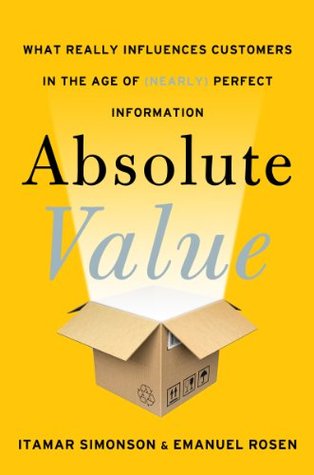More on this book
Kindle Notes & Highlights
Started reading
May 23, 2018
“A company’s brand is more important today than it has ever been.” “Nurturing loyalty should be the marketer’s primary, day-to-day concern.” “All customers are irrational.” “An overload of options may actually paralyze people.” “Positioning is the most important part of the marketing game.”
The new information environment around us allows consumers to predict much more accurately the experienced quality (or absolute value) of products and services they consider getting.
When quality can be quickly assessed, people are less hesitant to try something new, which means that newcomers like ASUS can enjoy lower
consultants and scholars frequently associate with this story: If you want to boost the sales of a product, launch a more expensive one. Steering consumers to midrange products by introducing a high-end option sounds like a solid strategy, but how useful is it in today’s shopping environment?
“cognitive misers.”
“strawman,”
Being Apple is still better than being ASUS. Brand equity is still valuable in terms of name recognition, continuity, and in some cases, emotional attachment and prestige. (As we are writing this, Shih is benefiting in this
revolutions are messy and rarely happen overnight.
situations where consumers still heavily depend on relative evaluations. Finally, it’s worth mentioning
Numerous studies have demonstrated that consumers’ decisions can be influenced in different ways. These influences fall into three broad categories—framing effects, choice context effects,
“couch tracking,” “faster verdict,” and “more from the head.”
Benjamin Franklin famously said that three people can keep a secret if two of them are dead.
Nielsen study conducted among 28,000 Internet respondents in fifty-six countries found that online consumer reviews are the second most trusted source of information about products, with 70 percent of respondents indicating they trust messages from this source “completely” or “somewhat” (a 15 percent increase in four years).
David Aaker and other scholars have pointed out over the years, brand equity has four components:
awareness, perceived quality, mental associations, and loyalty.
(For a selection of those tools, go to this book’s website, www.AbsoluteValueBook.com.)
“There’s only one word that’s banned in our company: brand,” James Dyson said at a 2012 conference. “We’re only as good as our latest product. I don’t believe in brand at all.”
loyalty is the key to profitability; various statistics have been used, such as the impact of addressing a complaint on repeat purchase and the lower cost of retaining
key example is the classic adoption model, which still guides many strategies. This model (which also
roots in a study of adoption among Iowa farmers)4 classifies the population into five adoption categories: innovators, early adopters, early majority, late majority, and laggards. This is the way many observers
Granovetter showed that your closest friends and family—those who move in the same social circles as you do—are likely to be exposed to the same sources of information as you are. Therefore, they don’t usually bring you fresh news. On the other hand, people outside this group are much more likely to hear things that you do not. In this way, weak ties with distant acquaintances
Bowling Alley. The idea is to find—within the early majority—some niches or segments that desperately need the product. Once they adopt the product, they will tell other pragmatists in other segments and so, segment after segment—like pins in a bowling alley—the technology will spread.
research has highlighted five key innovation characteristics as the drivers of adoption rate: relative advantage, compatibility, observability, communicability, and trialability. As summarized in Rogers’s treatise, these factors have been shown to underlie the success or failure of innovations
In the automotive industry, for example, Volvo captured “safety,” Ferrari got “speed,” Lincoln stood for “luxury,” and Toyota captured “reliability.”
PhoneDog,
can satisfy wants, many of which cannot be identified a priori,
Changing people’s perception, which has always been exceptionally difficult, is even more difficult today. It’s pointless to try to reposition a company without actual change on the ground. What you say (or how you say it) is less important today. It’s more about what you do. The name of the game is merit.
Influence Mix. We start with a simple idea: A person’s decision to buy is affected by a mix of three related sources: The individual’s Prior preferences, beliefs, and experiences (P) Others. Other people and information services (O) Marketers
the three main tasks of marketing communication were: generate interest, build preference for the product, and encourage purchase. (Of course, this is a simplified view, but it will serve us here.)
Brands still play a role as proxies for quality. Consumers still rely on their past satisfaction. Consumers may stay loyal to a brand. Positioning and persuasion techniques can work. Emotional appeals are as effective as in the past. Consumer preferences are susceptible to various seemingly irrational influences and manipulations.


